1 The postdark ages rediscovery of classicGreek texts artist
1) The post-dark ages rediscovery of classic/Greek texts, artistic ideals and the staging conventions / structural edicts of Aristotle are known as:
a) Classical Renaissance
b) The Satyr of Structure
c) Neoclassicism
d) Aristocratic Acronyms
2) One of the first writers to be considered a critic of plays was
a) Plato
b) Novick
c) Socrates
d) Aristotle
3) What poular medium most effectively and completely creates the appearance or illusion of realism?
a) Theatre
b) Film
c) Music
d) Dance
4) The reason that a character gets out of bed each day, her reason for being, can be described by her:
a) Hamartia
b) Hybris
c) Super-Objective
d) Epitatis
5) The fourth wall
a) was not a concept that came into prominence until the advent of Realism in the 19th century.
b) is another way of saying “The Domestic Press”.
c) is the space, within the proscenium arch, through which the audience watches the action but through which the characters cannot see.
d) A and C
6) When we discuss a show\'s theatricality, we are talking about bridging the distance between the represented and the real with creative solutions that:
a)
Do not pretend the distance doesn\'t exist and
b)
Use that distance as on opportunity to build an additional layer of meaning into the production
c)
Help to define and articulate THEME
d)
Create realistic, believable spectacle
e)
A, B, and C
7) All of the following are true of Tragedy except:
a)
Involves a character of nobility or in a position of prestige or power
b)
The protagonist is shown to have Hamartia or “ a tragic flaw”
c)
We exercise empathy for the protagonist and experience Katharsis as a result
d)
The “Alienation” or “Distancing” Effect is used to remind the audience that this is a
play and there is a lesson to be learned
e)
The Protagonist shows “per-severance” in the face of great tragedy and, as such,
changes the world for the better.
8) Three kinds of religious plays in Medieval Europe were Mystery Plays, ______________________, and _____________________.
a)
Comedies and Tragedies.
b)
Satyrs and Satires.
c)
Achrnological and Chronological.
d)
Miracle Plays and Morality Plays
9) When we discuss \"Embracing the Remix\" we are referring to
a)
An understanding that our creativity comes from without, not from within.
b)
Freeing ourselves from the anxiety associated with the unrealistic need to be unique.
c)
An appreciation of the fact that all artistic endeavors involve some kind of copying and repurposing.
d)
All of the above.
10) An analogue experience is one in which we comit to the whole, from begining to end and through the good and bad.
a) True
b) False
11) A digital experience is one that is infinitely customizeable and responds to our moment-to-moment whims.
a) True
b) False
12) The terms Representational and Presentational are useful, consistent ways of defining the the performative nature of an actor\'s skill.
a) True
b) False
13) \"The Method\" refers to Stanisalvski\'s Psycho Technique, a codified system for acting born of Stanisalvski\'s work at the MAT, his love for the the theatre and his empirical, scientific mind.
a) True
b) False
14) All of the following are American acting professionals except.
a) Uta Hagen
b) Stella Adler
c) Phillup Marlowe
d) Robert Cohen
e) Lee Strasberg
15) The academic research that a director uses to help the cast and crew understand the the world of the play is call DRAMATURGICAL RESEARCH.
a) True
b) False
16) Expert opinions should be the basis of all of our work in the theatre. Experts know best!
a) True
b) False
17) What are the four types of theatre discussed in Peter Brook\'s The Empty Space ?
| a) | Do not pretend the distance doesn\'t exist and |
| b) | Use that distance as on opportunity to build an additional layer of meaning into the production |
| c) | Help to define and articulate THEME |
| d) | Create realistic, believable spectacle |
| e) | A, B, and C |
Solution
1) The post-dark ages rediscovery of classic/Greek texts, artistic ideals and the staging conventions / structural edicts of Aristotle are known as:
a) Classical Renaissance
b) The Satyr of Structure
c) Neoclassicism
d) Aristocratic Acronyms
Answer: b
2) One of the first writers to be considered a critic of plays was
a) Plato
b) Novick
c) Socrates
d) Aristotle
Answer-d
3) What poular medium most effectively and completely creates the appearance or illusion of realism?
a) Theatre
b) Film
c) Music
d) Dance
Answer-a
4) The reason that a character gets out of bed each day, her reason for being, can be described by her:
a) Hamartia
b) Hybris
c) Super-Objective
d) Epitatis
Answer-d
5) The fourth wall
a) was not a concept that came into prominence until the advent of Realism in the 19th century.
b) is another way of saying “The Domestic Press”.
c) is the space, within the proscenium arch, through which the audience watches the action but through which the characters cannot see.
d) A and C
Answer-d
6) When we discuss a show\'s theatricality, we are talking about bridging the distance between the represented and the real with creative solutions that:
a)
Do not pretend the distance doesn\'t exist and
b)
Use that distance as on opportunity to build an additional layer of meaning into the production
c)
Help to define and articulate THEME
d)
Create realistic, believable spectacle
e)
A, B, and C
Answr-e
7) All of the following are true of Tragedy except:
a)
Involves a character of nobility or in a position of prestige or power
b)
The protagonist is shown to have Hamartia or “ a tragic flaw”
c)
We exercise empathy for the protagonist and experience Katharsis as a result
d)
The “Alienation” or “Distancing” Effect is used to remind the audience that this is a
play and there is a lesson to be learned
e)
The Protagonist shows “per-severance” in the face of great tragedy and, as such,
changes the world for the better.
Answer-d
8) Three kinds of religious plays in Medieval Europe were Mystery Plays, ______________________, and _____________________.
a)
Comedies and Tragedies.
b)
Satyrs and Satires.
c)
Achrnological and Chronological.
d)
Miracle Plays and Morality Plays
Answer-b
9) When we discuss \"Embracing the Remix\" we are referring to
a)
An understanding that our creativity comes from without, not from within.
b)
Freeing ourselves from the anxiety associated with the unrealistic need to be unique.
c)
An appreciation of the fact that all artistic endeavors involve some kind of copying and repurposing.
d)
All of the above.
Answer-d
10) An analogue experience is one in which we comit to the whole, from begining to end and through the good and bad.
a) True
b) False
Answer- true
11) A digital experience is one that is infinitely customizeable and responds to our moment-to-moment whims.
a) True
b) False
Answer-b
12) The terms Representational and Presentational are useful, consistent ways of defining the the performative nature of an actor\'s skill.
a) True
b) False
Answer-True
13) \"The Method\" refers to Stanisalvski\'s Psycho Technique, a codified system for acting born of Stanisalvski\'s work at the MAT, his love for the the theatre and his empirical, scientific mind.
a) True
b) False
Answer-false
14) All of the following are American acting professionals except.
a) Uta Hagen
b) Stella Adler
c) Phillup Marlowe
d) Robert Cohen
e) Lee Strasberg
Answer-a
15) The academic research that a director uses to help the cast and crew understand the the world of the play is call DRAMATURGICAL RESEARCH.
a) True
b) False
Answer-True
16) Expert opinions should be the basis of all of our work in the theatre. Experts know best!
a) True
b) False
Answer-False
17) What are the four types of theatre discussed in Peter Brook\'s The Empty Space ?
Answer:
Deadly theatre\", \"Holy theatre\", \"Rough theatre\" and \"Immediatetheatre\"
| a) | Do not pretend the distance doesn\'t exist and |
| b) | Use that distance as on opportunity to build an additional layer of meaning into the production |
| c) | Help to define and articulate THEME |
| d) | Create realistic, believable spectacle |
| e) | A, B, and C |
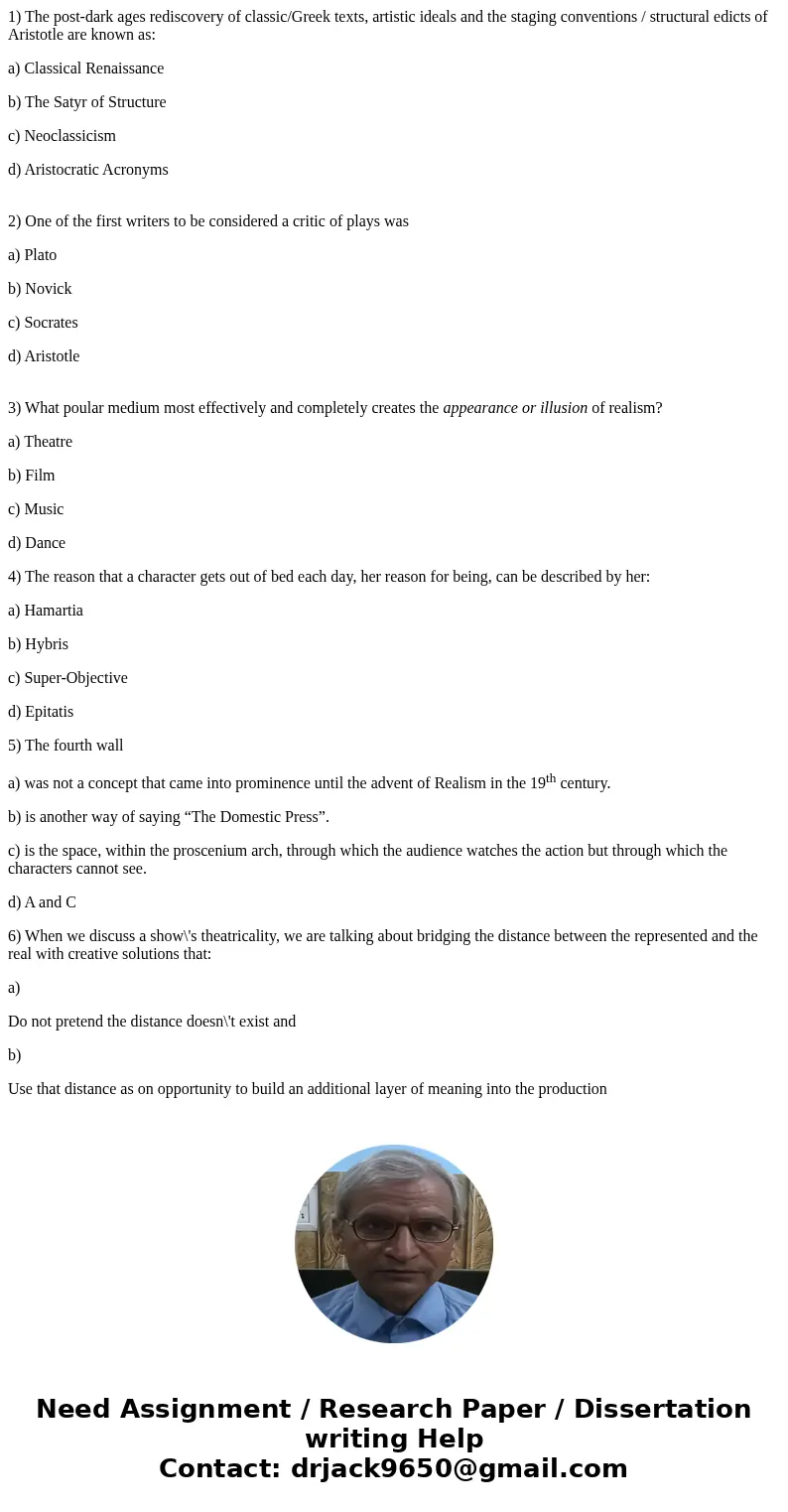
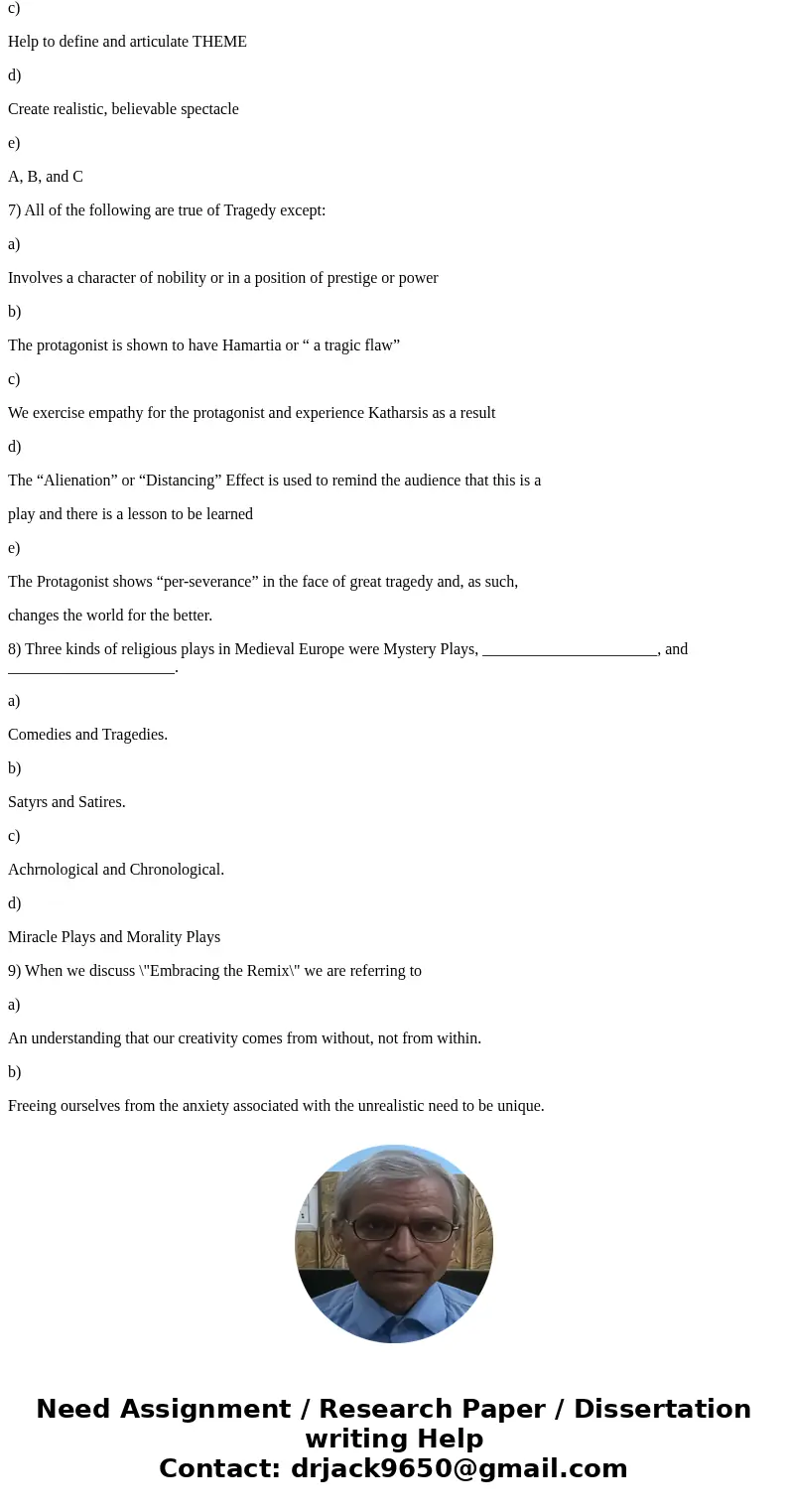
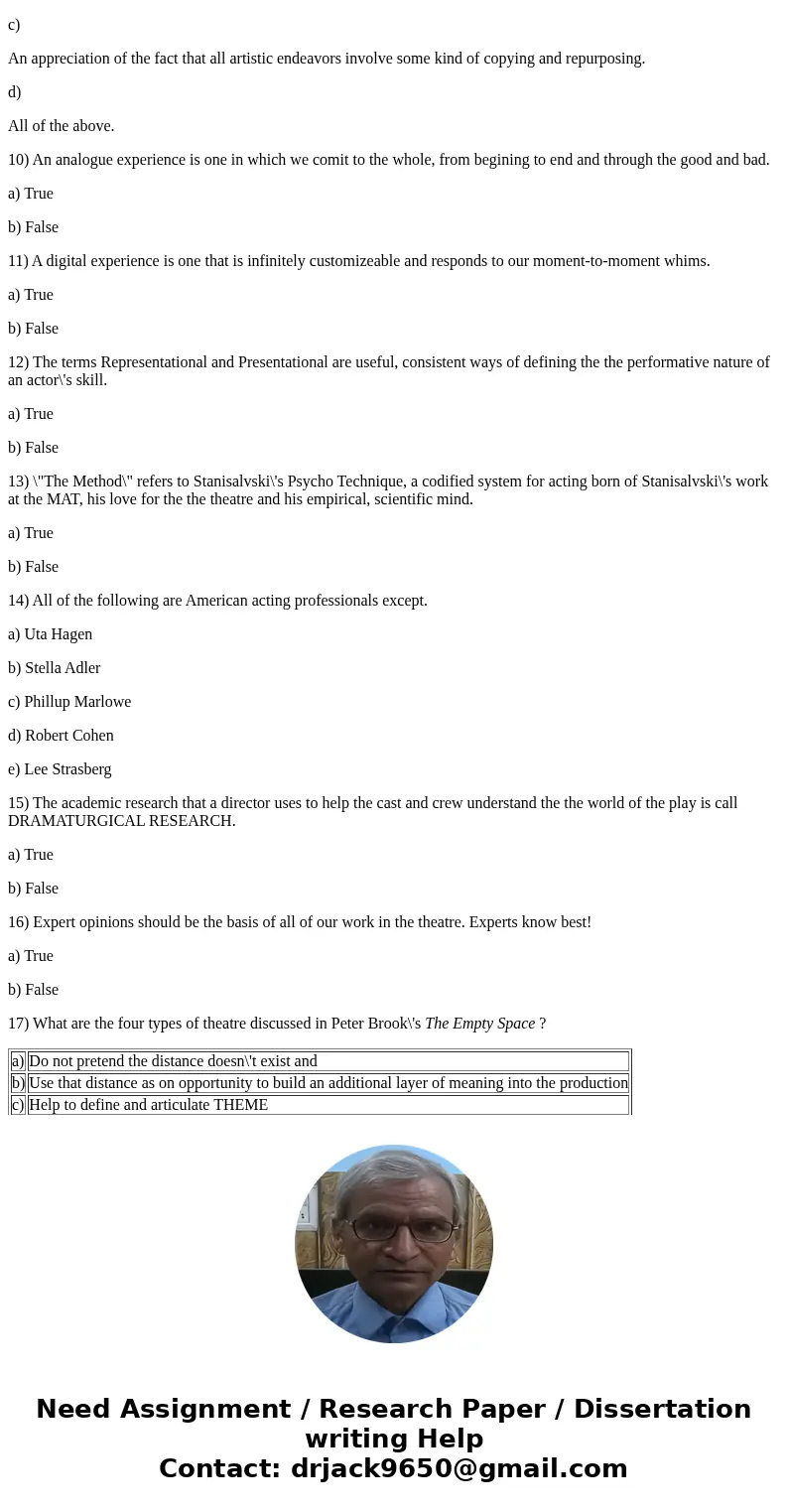
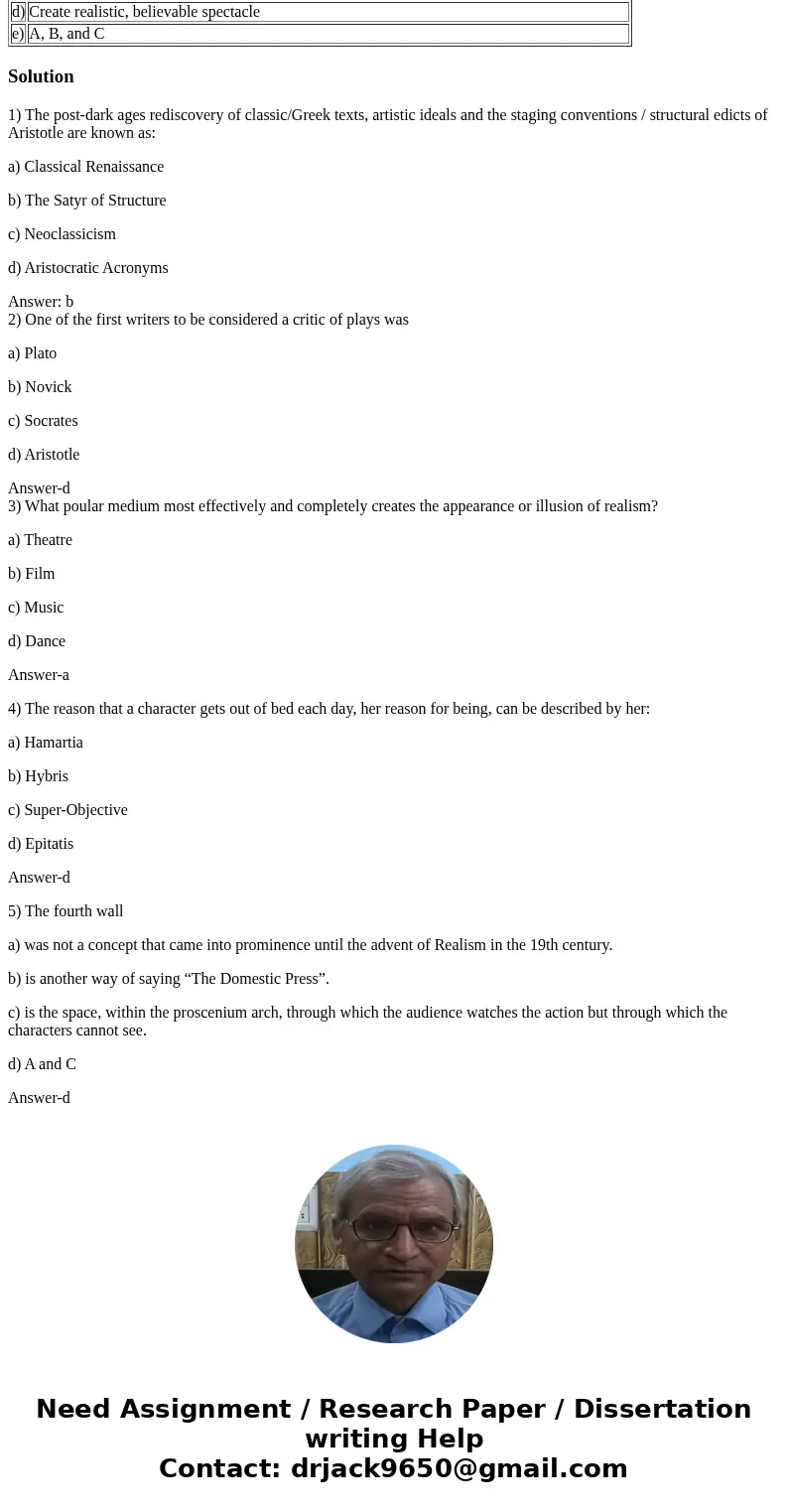
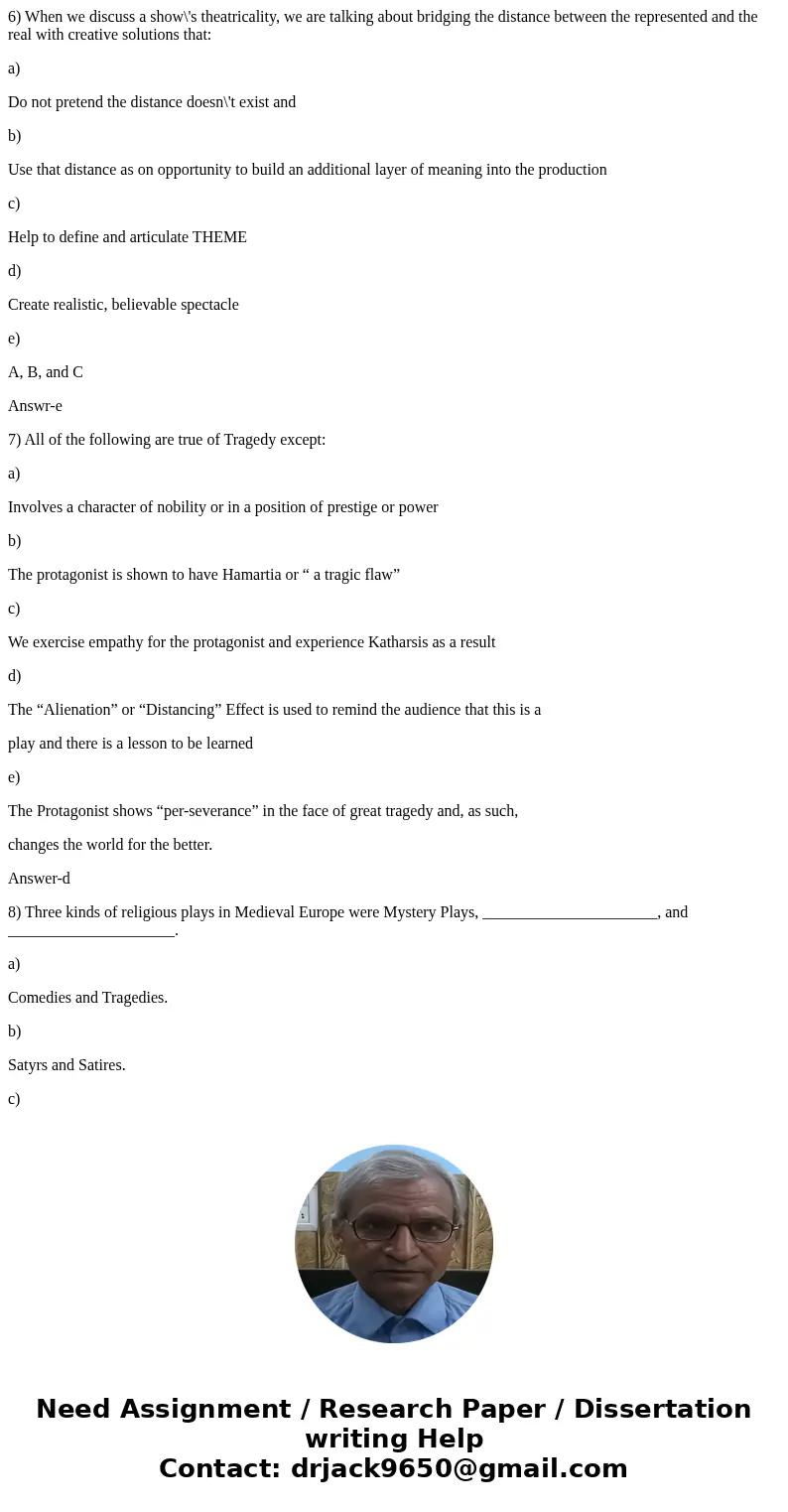
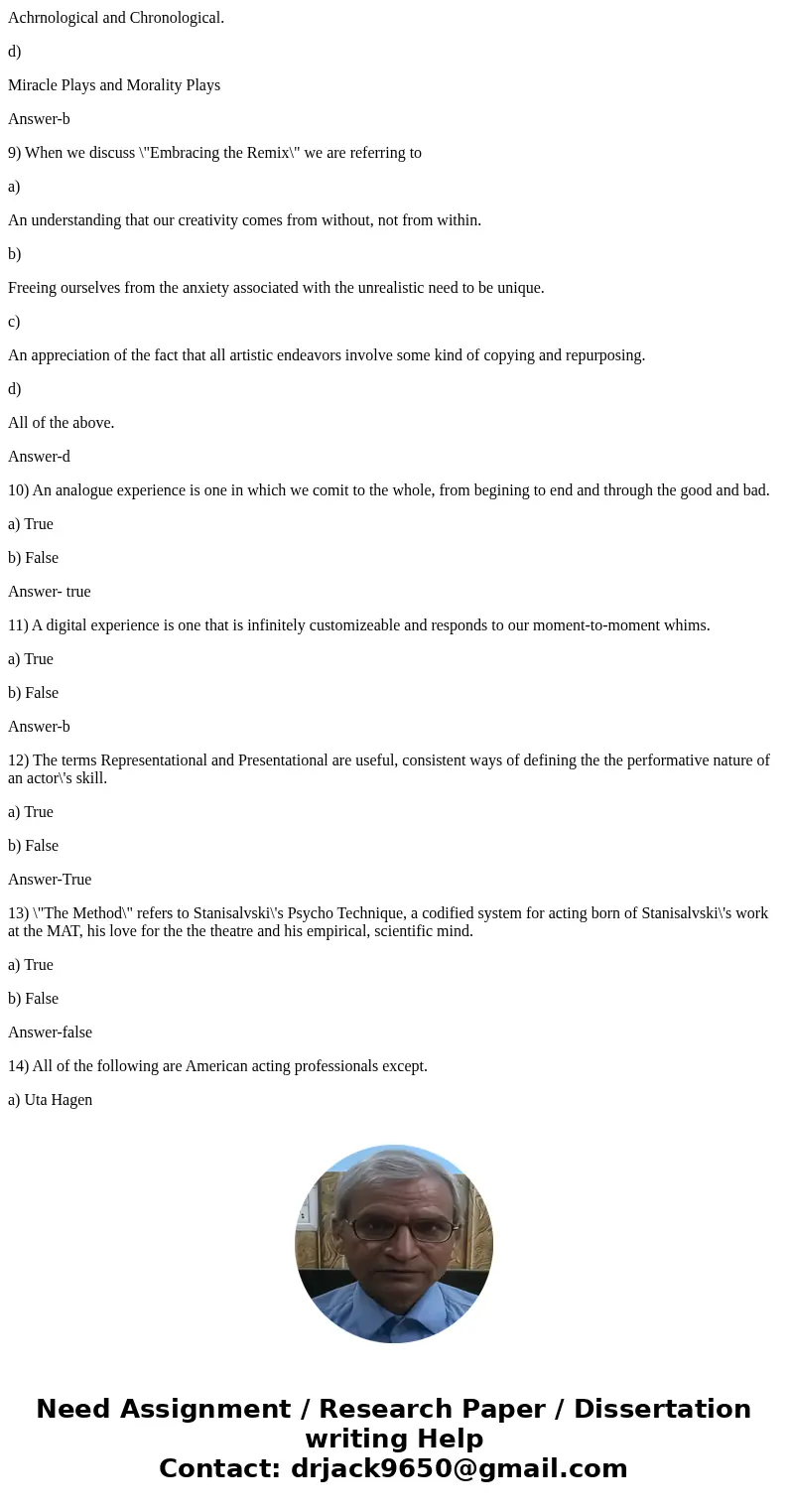
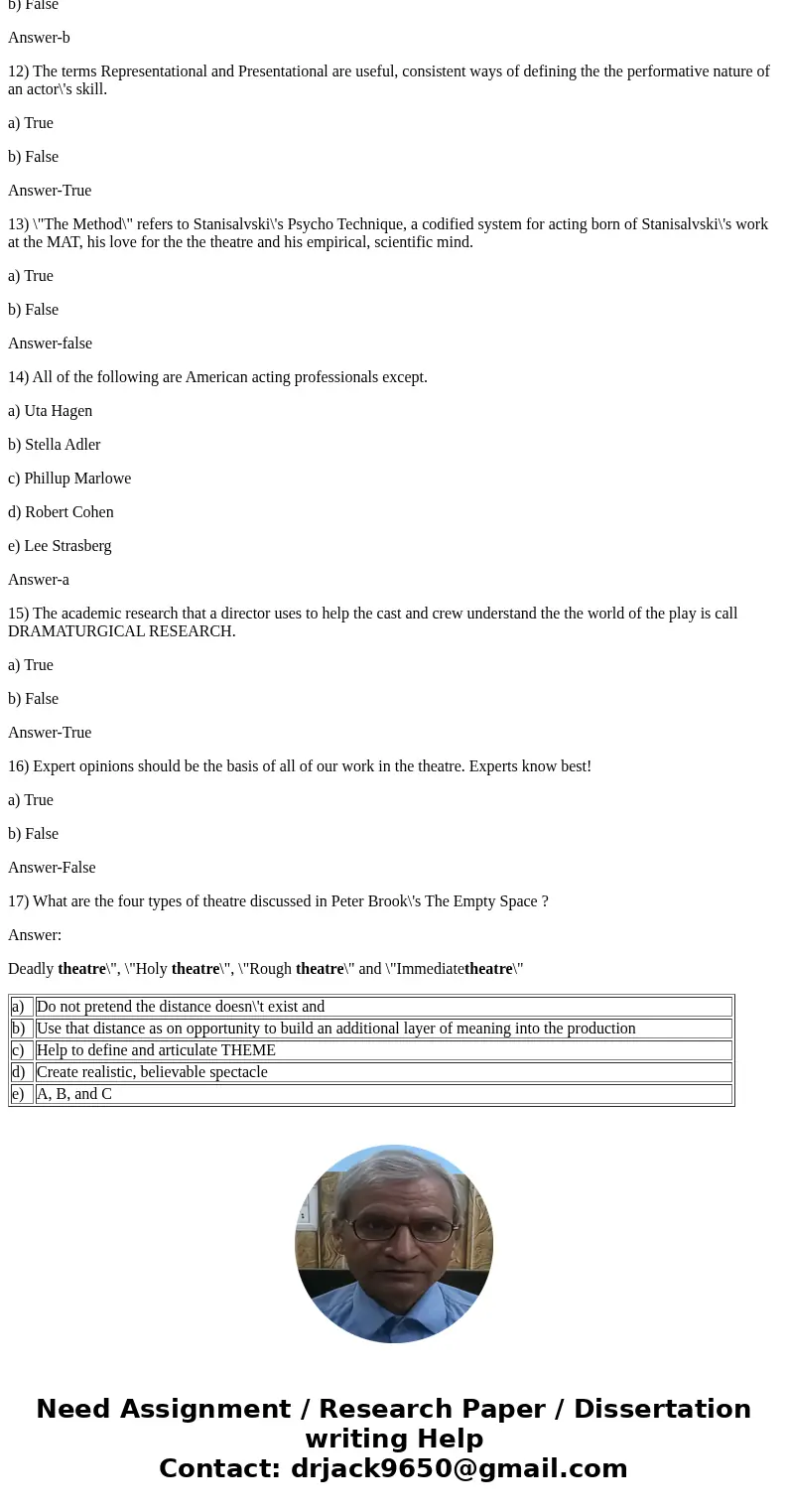
 Homework Sourse
Homework Sourse